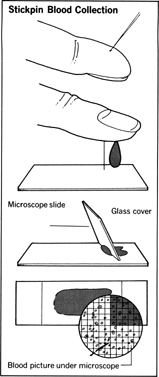Physicians and Diagnostic Procedures - The physical examination
One of the first questions many people have about the physical exam is “How often should I have one?” Visits for infants from birth to 18 months are typically scheduled at 2, 4, 6, 15, and 18 months. Visits for children from 2 to 18 are typically scheduled once a year. Visits for individuals aged 19 to 65 are recommended every 1 to 3 years, for most people beginning on the low side (every 3 years) and progressing to every year as one approaches age 65. After age 65 annual visits are recommended.
A typical physical examination will include a careful health appraisal by an examining physician, including a detailed health history of the patient and study of the patient's body appearance and functions.
The patient's medical history is important because the physician needs to know any medical problems the patient may have had in the past, including operations or pregnancies, medications the patient is allergic to or is currently taking, and any incidence of family illnesses that may make the patient more susceptible to such things as heart disease or cancer.
After the medical history has been recorded or updated, the physician may begin a general inspection of the patient's body, beginning with the head and neck and working down to the feet. The physician looks for possible deformities, scars or wounds, pulsations, or throbbing areas. Bruises, areas of skin peeling or flaking, areas of heavy skin pigmentation or loss of pigmentation, hair distribution, perspiration or goose bumps, firmness or slackness of the skin, warts, calluses, and other features are noted.
The physician usually checks the exterior of the body by a method known as palpation , which means feeling with the fingers and hands. Rough vibrations from a disorder in the respiratory system, the trembling sensation of blood encountering an obstruction, or the grating feeling of a bone deformity can be detected during palpation. In addition to palpation, the physician may apply percussion , or tapping, of certain body areas. Tapping the chest, for example, gives the physician some information about the condition of the lungs. A related technique, auscultation , involves listening to sounds within the body through a stethoscope. During percussion, the physician listens for changes in sounds that range from resonance over hollow spaces to dullness over solid or muscular areas. Lack of resonance over a normally resonant area of the lung might indicate fluid, pneumonia, or perhaps an abnormal mass. Percussion may also give the first sign of enlargement of organs, such as the liver, heart, or spleen. During auscultation, the physician listens for abnormal breathing sounds as the air rushes in and out of the lungs. Abnormal breathing sounds can indicate specific aberrations in lung function. In auscultation of the heart, the physician listens for extra heartbeats, rubbing sounds, the rumbling noises of a heart murmur, or the sounds of normally functioning heart valves opening and closing.
The physician may also use the stethoscope to listen to sounds beyond the chest area. He or she may listen to the sounds of blood flowing through vessels of the neck, bowel sounds through the wall of the abdomen, and the subtle noises made by joints, muscles, and tendons as various limbs are moved.
Weight, height, blood pressure, and pulse rate are also checked as part of any routine examination.


Comment about this article, ask questions, or add new information about this topic: